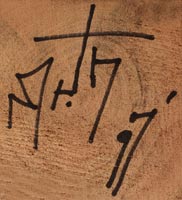Neil Randall David, Sr., Hopi-Tewa Carver
+ Add Artist to My Preferences
Neil Randall David Sr. is one of four Hopi artists who founded Artist Hopid. His father is from the Hopi village of Walpi and his mother came from Tewa ancestry that settled among the Hopi after the great Pueblo Revolt against the Spaniards in 1680. Once recognized for his paintings, he is now best known for his Katsina doll carvings.
For the Hopi there is an order that has persevered for centuries despite a perpetual influx of foreign influences. Always struggling to explain its ancient self-contained culture to uncomprehending strangers, the Hopi way continues to survive. This survival, to a great extent, has been- made possible by individuals of strong character and art. So at ease are the members of this culture with drawing, painting, carving, dance and making music that the Hopi have been described as the largest artistic community in the world.

Neil David, Sr., a Hopi-Tewa artist living in the village of Hano on First Mesa in Northern Arizona, was raised knowing artistic expression as a natural human activity. From his earliest years, Neil has loved nothing more than drawing and sculpting. Always recognized for his special gift, he stands out in a culture richly populated with talented individuals. Neil has not strayed from the ethos of his people, a fact evident in his art and life.
Neil David and his wife Dealva, have three sons and a daughter. Within the David family traditional Hopi values shape and mold every aspect of life. Speaking in their native tongue, the same unwritten history and legends from generations before are preserved. When combined with the visual experiences at hand, a lasting and believing attitude toward the Hopi way is engrained. Neil's children learn their culture more fully through art influenced by their father's talent.
His art depicts Hopi ceremonial life: the stagelike settings of dwelling and plaza, the preparations for dance and the final manifestation of Kachinas, masked forms and visiting skydwellers in their villages. Neil's religious upbringing and participation has been and still is a constant source of inspiration for his art.
Neil Randall David, Sr. (1944- ) is one of the founders of the Artist Hopid group of cultural emissaries from the Hopi to the world at large. Neil has traveled extensively throughout the United States and to the far reaches of both North and South America, demonstrating the many forms of art native to the Hopi. His efforts continue to prove most fruitful as he receives numerous awards, while his works are shown at many exhibits and are widely publicized. Neil's personal commitment to his Hopi heritage and willingness to share his culture have earned him a great deal of respect from Hopi and non-Hopi alike.
In a giant mural measuring 8 by 34 feet, Neil initiated and created with fellow artists a symbolic calendar of Hopi ceremonial life. This magnificent work can be seen in the Hopi Cultural Center. It depicts the Snake Dance Ceremony, the Women's Society Knee High Dance, the Basket Dance, the mid-winter solstice changeover from the reign of the Bear Clan to that of the Kachina Clan, Buffalo Dances, Night Dances and the summer solstice. In these Hopi ceremonials Kachinas play a vital role.
Kachinas have survived on three levels for the Hopi; as dolls carved to instruct children in their appearance and roles in Hopi society; as masked dancers who emerge from the kivas at the appropriate times for ceremonies; and as supernatural beings whose personalities and histories have been preserved through long tradition. The Hopi people are always aware of the Kachinas who visit their mesas, interact with them and infuse their everyday events with a precious and spiritual meaning.
Exposure to the world beyond the mesas has led Neil to experiment with representing his world in other artistic media. Neil has gained considerable renown as a bronze artist for the casting he makes from his sculptures of cottonwood root, the traditional medium for Kachina dolls. He is also respected for his original graphics and lithographs. The challenge of sculpting in clay for the porcelain figurines in this series was a challenge easily met.
The porcelains in the American Indian Life and Legends Kachina series, therefore, are another extension of Neil's desire to communicate his culture's world view to others in a manner they find accessible and beautiful.
Reference: Hopi Katsina: 1,600 Artist Biographies by Gregory and Angie Yan Schaaf.
TAGS: Native American Paintings, Katsina dolls, Hopi Pueblo, Native Drawing, Native Painting, Carving, Hopi-Tewa , Bronze, Neil David, Jr.

